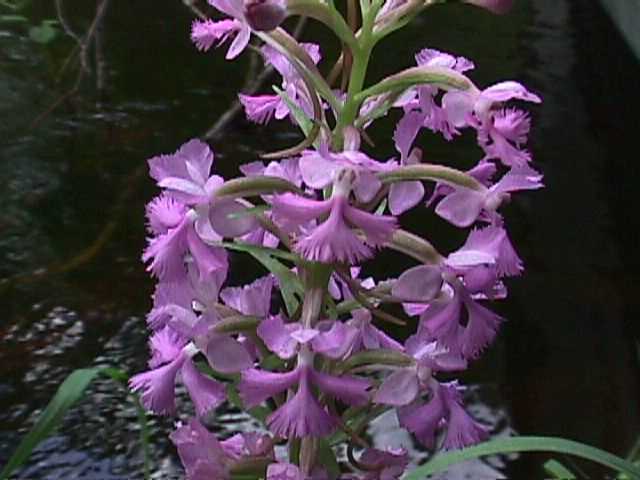


There are two species in our area - the "small" (Platanthera psycodes ) and the "large" (Platanthera grandiflora). Generally speaking, the only discernable difference is the size of the flowers - the "small" flowers about 1/2" wide, and the "large" flowers about 1". Thanks to an attentive (and knowledgeable) internet visitor, Charles McCartney, I can add some detail to this description to help you determine which species you've found. Following are his words:Flowers--Pink-purple and pale lilac, sometimes nearly white; fragrant, alternate, clustered in thick, dense spikes from 3 to 15 in. long. Upper sepal and toothed petals erect; the lip of deepest shade, 1/2 in. long, fan-shaped, 3-parted, fringed half its length, and prolonged at base into slender, long spur; stamen united with style into short column; 2 anther sacs slightly divergent, the hollow between them glutinous, stigmatic. Stem: 1 to 5 ft. high, angled, twisted. Leaves: Oval, large, sheathing the stem below; smaller, lance-shaped ones higher up bracts above. Root: Thick, fibrous.
Preferred Habitat--Rich, moist meadows, muddy places, woods.
Flowering Season--June-August.
Distribution--New Brunswick to Ontario; southward to North Carolina, westward to Michigan.
Because of the singular and exquisitely unerring adaptations of orchids as a family to their insect visitors, no group of plants has greater interest for the botanist since Darwin interpreted their marvellous mechanism, and Gray, his instant disciple, revealed the hidden purposes of our native American species, no less wonderfully constructed than the most costly exotic in a millionaire's hothouse.
A glance at the spur of this orchid, one of the handsomest and most striking of its clan, and the heavy perfume of the flower, would seem to indicate that only a moth with a long proboscis could reach the nectar secreted at the base of the thread-like passage. Butterflies, attracted by the conspicuous color, sometimes hover about the showy spikes of bloom, but it is probable that, to secure a sip, all but possibly the very largest of them must go to the smaller Purple-fringed Orchis, whose shorter spur holds out a certain prospect of reward; for, in these two cases, as in so many others, the flower's welcome for an insect is in exact proportion to the length of its visitor's tongue. Doubtless it is one of the smaller sphinx moths, such as we see at dusk working about the evening primrose and other flowers deep of chalice, and heavily perfumed to guide visitors to their feast, that is the great Purple-fringed Orchid's benefactor, since the length of its tongue is perfectly adapted to its needs. Attracted by the showy, broad lower petal, his wings ever in rapid motion, the moth proceeds to unroll his proboscis and drain the cup that is frequently an inch and a half deep. Thrusting in his head, either one or both of his large, projecting eyes are pressed against the sticky button-shaped discs to which the pollen masses are attached by a stalk, and as he raises his head to depart, feeling that he is caught, he gives a little jerk that detaches them, and away he flies with these still fastened to his eyes.